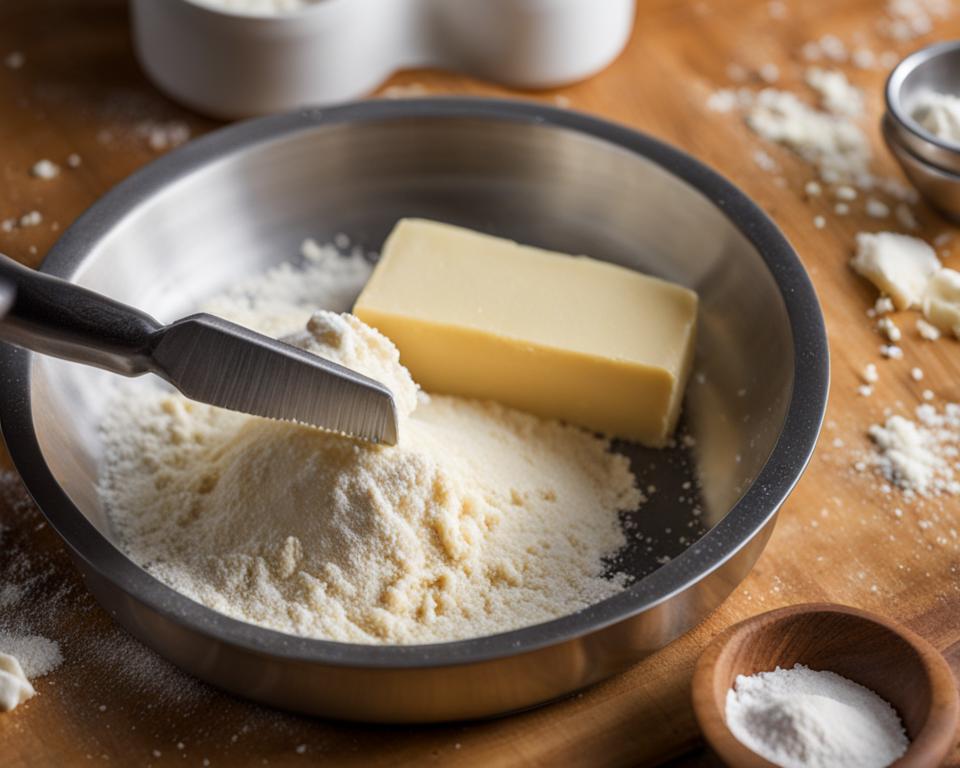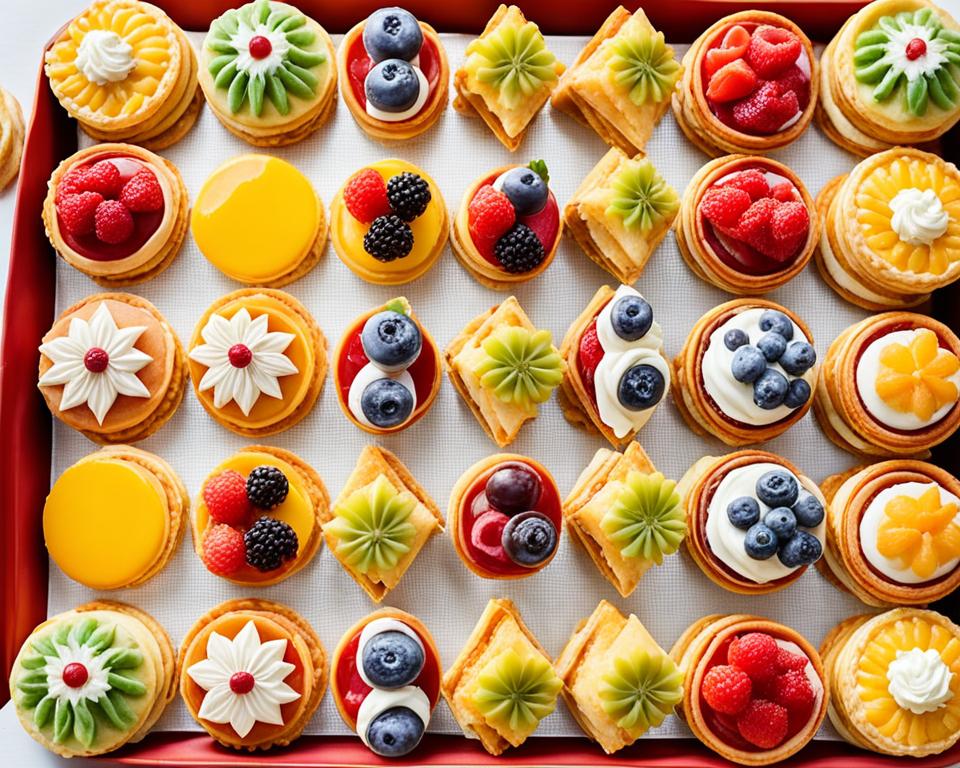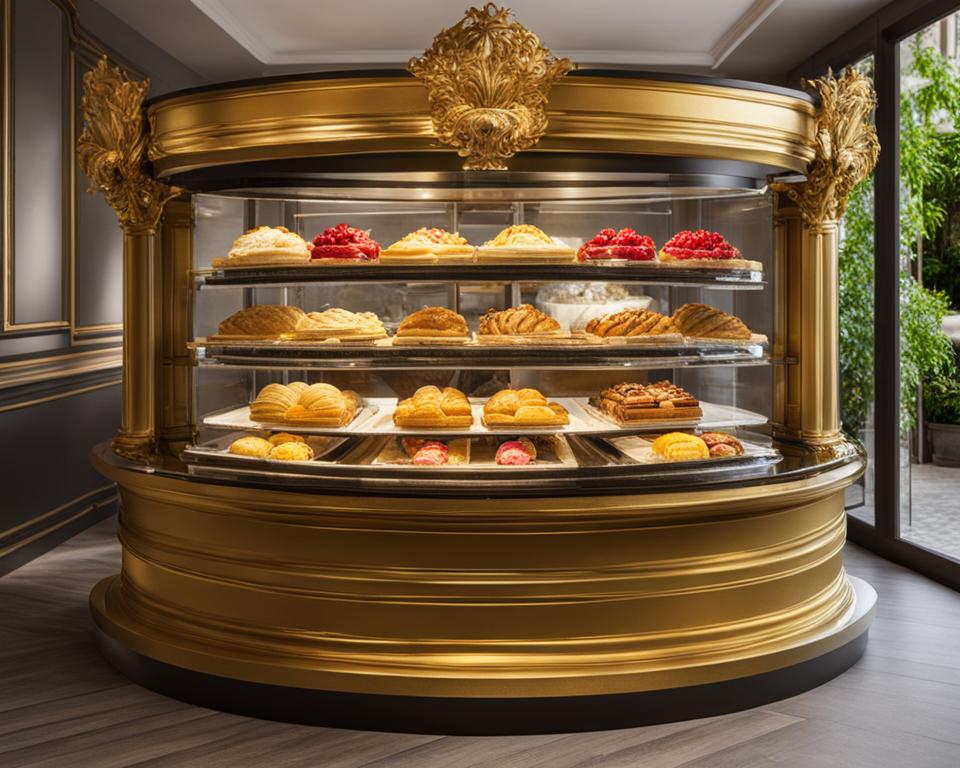When it comes to baking, achieving the perfect flaky texture is a coveted skill. Whether it’s a buttery pastry, a delicate pie crust, or even a biscuit, that light and airy flakiness adds an extra layer of deliciousness to any baked good.
The secret to achieving flaky texture lies in the incorporation of solid butter or fat into the dough. These chunks of fat create pockets that melt during baking, releasing steam and creating those desirable flaky layers we all love. But there’s more to it than just adding fat to the mix.
In our exploration of flaky texture, we’ll uncover the different types of pastry and their distinctive textures. We’ll also delve into the process of making flaky pastry, the factors that affect its quality, and provide you with some tips for working with this delicate dough. So let’s roll up our sleeves and embark on this flaky adventure!
Key Takeaways:
- Flaky texture is achieved by incorporating chunks of solid butter or fat into the dough, allowing for the creation of pockets that melt during baking.
- There are different types of pastry with varying textures, including crumbly pastry, flaky pastry, and laminated pastry.
- Making flaky pastry involves a specific process, including the incorporation of fat, rolling and folding the dough, and proper temperature control.
- Flaky pastry differs from puff pastry in terms of fat and layer distribution, volume after baking, and application possibilities.
- Proper handling and temperature control are essential when working with flaky pastry to ensure successful results.
Types of Pastry and Their Textures
When it comes to creating delectable baked goods, understanding the different types of pastry and their textures is essential. There are three main types of pastry: crumbly, flaky, and laminated. Each type offers a unique texture experience, ranging from tender and crumbly to light and airy. Let’s explore these pastry types and their delightful textures.
Crumbly Pastry
Crumbly pastry is known for its delicate and tender texture. It effortlessly crumbles with each bite, creating a melt-in-your-mouth sensation. This type of pastry is achieved by blending cold fat, such as butter or shortening, with flour until the mixture resembles coarse crumbs. The presence of fat creates a tender texture that complements sweet and savory fillings perfectly.
Flaky Pastry
Ah, the beloved flaky pastry! It’s the epitome of indulgence with its distinct layers that crumble upon touch. Flaky pastry is made by incorporating solid chunks of fat, like butter or lard, into the dough. During baking, these fat pockets melt and release steam, creating airy layers. The result? A texture that’s crispy, buttery, and oh-so-flaky. Flaky pastry is a staple in pie crusts, turnovers, and other delicious treats.
“Flaky pastry is the perfect canvas for both sweet and savory fillings. Its luscious texture elevates every bite.”
Laminated Pastry
Laminated pastry, also referred to as puff pastry, takes texture to a whole new level. The secret lies in the meticulous process of incorporating layers of dough and fat. By rolling and folding the dough multiple times, a multitude of airy layers is formed. The result is a pastry with a light and delicate texture that practically melts in your mouth. Laminated pastry is the star of classic treats like croissants and Danish pastries.
To help you visualize the differences between these pastry types, here’s a handy table:
| Pastry Type | Texture |
|---|---|
| Crumbly Pastry | Tender and crumbly |
| Flaky Pastry | Distinctly flaky and buttery |
| Laminated Pastry | Light, airy, and delicate |
Now that you have a better understanding of the types of pastry and their textures, you can experiment with these techniques in your baking adventures. Whether you crave the tender crumble of crumbly pastry, the flaky layers of flaky pastry, or the airy delicacy of laminated pastry, the possibilities are endless. Let your taste buds guide you as you create delightful pastries that satisfy every craving.
Making Flaky Pastry
When it comes to creating flaky pastry, the secret lies in the incorporation of small chunks of fat into the dough. This fat-to-flour ratio is typically 3:4, ensuring the perfect balance for a tender and flaky texture. Rolling and folding the dough four times during the preparation process is crucial for achieving those desirable layers that result in a crisp and delicate pastry.
In traditional flaky pastry recipes, a combination of lard and butter is often used to enhance the flavor and texture. However, other fats can also be utilized to suit personal preferences and dietary requirements. Experimenting with different fat options can lead to exciting variations in taste and texture.
“Incorporating small chunks of butter or lard into the dough and rolling and folding it multiple times creates pockets of fat that melt during baking, resulting in a flaky and irresistible pastry.”
Making flaky pastry requires precision and technique. The process of rolling and folding the dough creates multiple layers, allowing the fat to create air pockets that give the pastry its distinct flaky texture. Take a moment to appreciate the beauty of this process:
With each roll and fold, the layers of fat and dough become intertwined, ensuring even distribution and creating a flawless texture. The result is a pastry that shatters delicately with each bite, revealing a buttery goodness that is hard to resist.
Whether you choose to use lard, butter, or other fats, mastering the art of making flaky pastry opens up a world of possibilities in your baking repertoire. From sweet to savory applications, the flaky texture adds an extra dimension of enjoyment to your favorite treats.
Differences Between Flaky Pastry and Puff Pastry
Flaky pastry and puff pastry are both delicious types of dough used in various baking applications. While they share similarities in their creation process, they also have distinct differences in terms of fat content, number of layers, volume after baking, and ideal applications.
Flaky pastry, as the name suggests, is known for its flaky and tender texture. It is made by incorporating small chunks of fat – typically butter or lard – into the dough. This creates discontinuous layers that result in a crisp and flaky pastry. Flaky pastry has a fat-to-flour ratio of 3:4 and is rolled and folded four times. Despite the lower fat content and fewer layers compared to puff pastry, flaky pastry still offers a delightful eating experience.
| Aspect | Flaky Pastry | Puff Pastry |
|---|---|---|
| Fat Content | Less fat | More fat |
| Number of Layers | Fewer layers | More layers |
| Volume After Baking | Lower volume | Higher volume |
| Ideal Applications | Pie crusts, turnovers | Vol-au-vents, bouchees |
Puff pastry, on the other hand, is all about volume and lightness. It contains a higher amount of fat and has many more layers than flaky pastry. Puff pastry is achieved through a process called lamination, where layers of dough are alternated with layers of butter or butter substitute. This results in a pastry that puffs up dramatically when baked, creating a light and airy texture. Puff pastry is often used for delicate pastries like vol-au-vents and bouchees.
In summary, the main differences between flaky pastry and puff pastry lie in their fat content, number of layers, volume after baking, and ideal applications. Flaky pastry, with its unique combination of fat and layers, is perfect for pie crusts and turnovers. Puff pastry, with its higher fat content and numerous layers, is ideal for creating light and impressive pastries like vol-au-vents. Both types of pastry have their own distinct qualities and can elevate various baked goods to new heights.
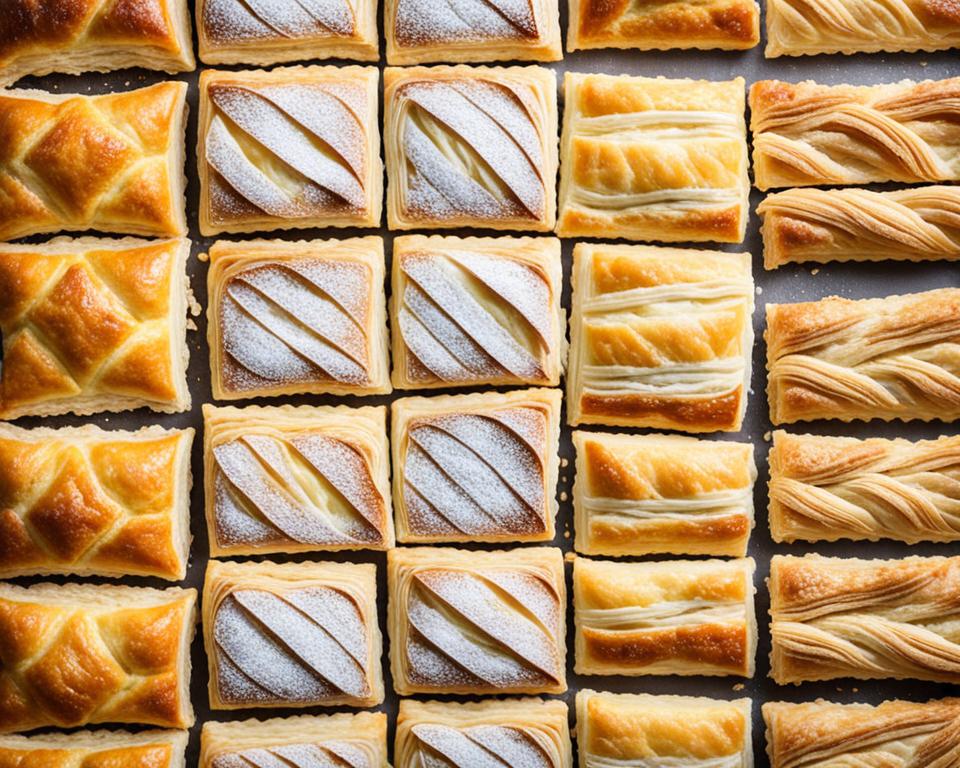
References:
- Martha Stewart – Flaky Pastry: https://www.marthastewart.com/318656/flaky-pastry
- King Arthur Baking – Puff Pastry vs. Flaky Pastry: https://www.kingarthurbaking.com/blog/2016/10/21/whats-the-difference-puff-pastry-vs-flaky-pastry
The Process of Making Flaky Pastry
Making flaky pastry involves several steps that contribute to its unique texture and delicious taste. By following these instructions, you can create a perfect flaky pastry every time.
Dough Formation
The first step in making flaky pastry is forming the dough. Start by cutting the fat, such as butter or lard, into the flour until it resembles coarse meal. This process helps distribute fat throughout the dough, creating flakiness.
Rolling and Folding
After forming the dough, it is mixed with liquids, such as water or milk, and allowed to rest. This resting period helps relax the gluten, making the dough easier to work with. Once rested, the dough is rolled out to the desired thickness using a rolling pin. It is important to maintain an even thickness throughout to ensure even baking.
Next, the dough is folded and laminated. You can achieve this by folding the dough in half and dotting it with additional fat, then folding it over again. This process is repeated several times, creating layers of dough and fat that will contribute to the flaky texture. Resting the dough between each fold allows it to relax and prevents the gluten from becoming too elastic.
Dough Thickness
The thickness of the dough is a crucial factor in flaky pastry. It is important to roll the dough to the correct thickness to achieve the desired texture. A thickness of approximately 1/8 inch is ideal for flaky pastry. This thickness allows for the right balance of crispness and flakiness when baked.
Once the dough is rolled and folded, it can be used immediately or stored in the freezer for later use. Freezing the dough helps maintain its structure and allows for easy preparation in advance.
By following these steps for making flaky pastry, you can create a delicious and perfectly textured pastry that will impress your family and friends.
Factors Affecting Flaky Pastry Quality
Flaky pastry quality is influenced by several important factors that need careful attention during the baking process. By understanding and controlling these factors, we can ensure the production of high-quality flaky pastries.
Dough Mixing
Proper dough mixing plays a critical role in achieving the desired flaky texture in pastries. Overmixing or undermixing the dough can have a significant impact on the fat incorporation and overall dough consistency. The dough should be mixed just enough to incorporate all the ingredients without overworking it. This ensures that the fat is evenly distributed throughout the dough, creating those desirable flaky layers.
Temperature Control
Temperature control is another crucial factor in flaky pastry production. The fat used in flaky pastry, such as butter or lard, must be kept at the optimal temperature throughout the process. If the fat becomes too warm, it can start melting and result in greasy pastries. On the other hand, if the fat is too cold, it can become too hard and make it difficult to achieve the desired flakiness. Maintaining the proper temperature of the ingredients and the production area is essential for consistent and high-quality flaky pastries.
Gluten Development
Gluten development is an important aspect of flaky pastry quality. Gluten, a protein present in flour, provides structure and elasticity to the dough. Adequate gluten development ensures that the dough has the necessary strength to handle the rolling, folding, and lamination process. Insufficient gluten development can result in a dough that is difficult to handle and prone to tearing during the lamination process. On the other hand, excessive gluten development can make the dough too elastic, resulting in a dense and chewy texture. Striking the right balance in gluten development is crucial for achieving the desired flaky texture in pastries.
To summarize, flaky pastry quality is influenced by factors such as proper dough mixing, temperature control, and gluten development. Paying attention to these factors during the baking process ensures the production of high-quality flaky pastries that have a delightful and crisp texture.
| Factors Affecting Flaky Pastry Quality | Description |
|---|---|
| Dough Mixing | Proper mixing ensures even fat incorporation and consistent dough consistency. |
| Temperature Control | Maintaining optimal temperature prevents fat from melting or becoming too hard. |
| Gluten Development | Adequate gluten development provides dough strength for handling folding and lamination. |
Flaky Pastry Recipe and Ingredients
When it comes to making flaky pastry, the recipe and ingredients play a crucial role in achieving that perfect texture. Let’s take a look at the essential components and techniques that make a flaky pastry truly outstanding.
Ingredients:
Here are the key ingredients you’ll need for a typical flaky pastry recipe:
| Ingredient | Amount |
|---|---|
| Pastry or bread flour | 2 cups |
| Butter or shortening | 1 cup (2 sticks) |
| Water | 1/2 cup |
| Salt | 1/2 teaspoon |
| Lemon juice | 1 teaspoon |
These ingredients provide the foundation for a flaky pastry with a delightful texture and savory flavor. The use of butter or shortening adds richness, while water and lemon juice enhance the dough’s texture and balance the flavors.
Recipe and Techniques:
- Start by scaling the ingredients according to the recipe. This ensures the right balance of flavors and textures.
- In a large bowl, mix the flour and salt together. Cut the butter into small cubes and add it to the flour mixture.
- Using a pastry cutter or your fingers, incorporate the butter into the flour until the mixture resembles coarse crumbs. This step is crucial for creating flaky layers in the pastry.
- Add the water and lemon juice to the mixture and gently mix until a rough dough forms. Be careful not to overmix, as this can result in a tough pastry.
- Shape the dough into a ball and wrap it in plastic wrap. Let it rest in the refrigerator for at least 30 minutes to allow the gluten to relax and the flavors to meld.
- Once the dough has rested, remove it from the refrigerator and place it on a lightly floured surface. Roll the dough into a rectangle or circle, depending on your recipe.
- Now comes the important step of lamination. Fold the dough into thirds, like a business letter, to create layers. Dot the surface with small pieces of butter between each fold for extra flakiness.
- Repeat the rolling and folding process at least three more times, resting the dough in the refrigerator between each fold. This builds up layers and creates the characteristic flaky texture.
Achieving the Perfect Flakiness:
“The key to achieving a perfect flaky texture lies in the careful mixing, resting, sheeting, and lamination of the dough. These techniques enable the fat to create layers, resulting in a delicately crisp and tender pastry.”
By following this flaky pastry recipe and incorporating the proper techniques, you’ll be able to enjoy mouthwatering pies, pastries, and more. The combination of precise ingredient scaling, gentle mixing, adequate resting, consistent sheeting, and careful lamination ensures a flaky texture that will have everyone coming back for seconds.
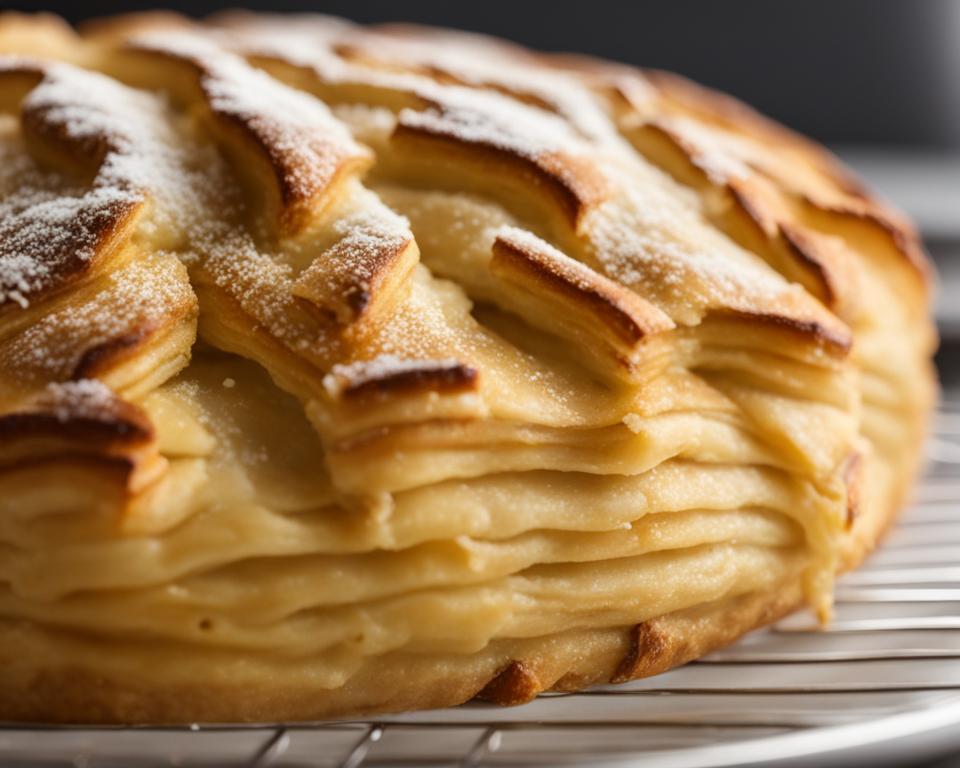
Continue reading to explore the various applications of flaky pastry in Section 8.
Applications of Flaky Pastry
Flaky pastry offers a wide range of applications, making it a versatile choice for both sweet and savory recipes. Its unique texture adds a delightful crispness to various baked goods, elevating the overall eating experience.
Here are some popular applications of flaky pastry:
- Pie crusts: Flaky pastry forms the perfect base for delicious pies of all kinds. Whether it’s a classic apple pie or a savory quiche, the tender and flaky crust adds a wonderful contrast to the filling.
- Turnovers: These handheld treats are made even better with flaky pastry. Whether filled with fruit, meat, or cheese, the crisp layers of the pastry provide a satisfying bite.
- Pasties: Popularized by Cornish cuisine, pasties are savory hand pies filled with meat, potatoes, and vegetables. Flaky pastry’s texture enhances the satisfaction of biting into these hearty treats.
- Sausage rolls: A classic favorite, sausage rolls are made with flaky pastry wrapped around savory sausage meat. The result is a delicious and crispy snack, perfect for any occasion.
Flaky pastry’s versatility extends beyond these applications, allowing you to explore new culinary creations. Its light and airy texture, combined with its rich, buttery flavor, make it a go-to choice for bakers and home cooks alike.
Remember, the key to achieving the perfect flaky texture lies in proper technique and high-quality ingredients. By mastering the art of flaky pastry, you can add a touch of elegance to your sweet and savory dishes.
Comparing Flaky Pastry Applications
| Application | Description |
|---|---|
| Pie crusts | A base for both sweet and savory pies, offering a tender and flaky texture. |
| Turnovers | Handheld treats filled with various ingredients, enclosed in a crispy flaky pastry. |
| Pasties | Savory hand pies traditionally filled with meat, potatoes, and vegetables, featuring a satisfying flaky crust. |
| Sausage rolls | Delicious snacks made by wrapping sausage meat in flaky pastry, resulting in a crispy exterior. |
| Other baked goods | Flaky pastry can be used in various other baked goods, providing a delightful crispness and enhancing the flavor. |
Tips for Working with Flaky Pastry
Working with flaky pastry requires proper handling and temperature control. Here are some tips to ensure successful results when working with this delicate dough:
- Proper Handling: Handle the dough with care and avoid overmixing. Mixing the dough just enough to incorporate the ingredients will prevent gluten development, resulting in a tender and flaky texture.
- Temperature Control: Maintain a low temperature in the production area to prevent the fat in the pastry from melting or becoming too hard. This will help preserve the flakiness and integrity of the dough.
- Rotation during Lamination: When laminating the dough by folding and layering, it’s essential to rotate the dough periodically. This ensures even distribution of the fat and reduces stress on the dough, resulting in consistent flakiness throughout.
By following these tips, you’ll be able to create perfect flaky pastry every time. Now let’s move on to some useful techniques and recipes for working with flaky pastry.
| Tip | Description |
|---|---|
| Proper Handling | Handle the dough with care, avoiding overmixing to maintain a tender and flaky texture. |
| Temperature Control | Keep a low temperature in the production area to prevent the fat from melting or becoming too hard, preserving the flakiness and integrity of the dough. |
| Rotation during Lamination | Rotate the dough periodically during lamination to ensure even distribution of the fat and reduce stress on the dough for consistent flakiness. |
Now that you are equipped with these valuable tips, let’s dive deeper into the techniques and recipes for working with flaky pastry in the following sections.
Conclusion
Flaky texture in baked goods adds a delightful crispness and enhances the overall eating experience. Achieving a flaky texture is possible in baking by incorporating chunks of fat into the dough and following proper techniques. When it comes to making flaky pastry, using well-chilled butter is key to creating those sought-after flaky layers. Baking at a high temperature helps to ensure the fat melts and releases steam, resulting in a light, airy, and flaky texture.
In addition to using the right ingredients and techniques, paying attention to factors like dough mixing and gluten development contributes to achieving a flaky texture. Proper mixing ensures the fat is evenly distributed, while gluten development adds strength and structure to the dough, making it easier to handle during folding and lamination.
To master the art of flaky pastry, experimentation is key. Trying out different recipes and applications will help you discover the perfect combination of flavors and textures. Whether you’re making pie crusts, turnovers, or other delicious creations, the flaky texture will elevate your baked goods to the next level. So, put on your apron, preheat that oven, and let the magic of flakiness unfold. Happy baking!
FAQ
What is flaky texture?
Flaky texture refers to a desirable trait in baked goods, such as pastry, pie crusts, and biscuits. It is achieved by incorporating chunks of solid butter or fat into the dough, which create pockets of fat that melt during baking, releasing steam and creating flakiness.
How can I achieve a flaky texture in baking?
To achieve a flaky texture, it is essential to use well-chilled butter and bake at a high temperature. Incorporating chunks of fat into the dough and following proper techniques, such as proper dough mixing and gluten development, also contribute to achieving a flaky texture.
What are the types of pastry and their textures?
There are three main types of pastry: crumbly pastry, which has a tender and crumbly texture; flaky pastry, which has a distinctive flaky texture; and laminated (or puff) pastry, which has a light and airy texture due to the many layers of dough and fat.
How is flaky pastry made?
Flaky pastry is made by incorporating small chunks of fat, such as butter or lard, into the dough. The dough is rolled and folded four times, creating discontinuous layers that result in a crisp and flaky texture.
What are the differences between flaky pastry and puff pastry?
Flaky pastry contains less fat and fewer layers compared to puff pastry. It produces a lower volume after baking and is better suited for applications like pie crusts and turnovers, while puff pastry is suitable for vol-au-vents and bouchees.
What is the process of making flaky pastry?
To make flaky pastry, a dough is formed by cutting fat into the flour until it resembles coarse meal. The dough is then mixed with liquids, rested, sheeted to the desired thickness, and laminated by folding and dotting the dough with fat between each fold.
What factors affect the quality of flaky pastry?
Proper dough mixing, temperature control, and gluten development are important factors that impact the quality of flaky pastry. Attention to these factors ensures a high-quality flaky pastry.
What is the recipe for flaky pastry and what are the ingredients?
A typical flaky pastry recipe includes pastry or bread flour, butter or shortening, water, salt, and lemon juice. The ingredients are scaled and mixed to form a rough dough, which is then rested, sheeted, and laminated through a series of folds with fat being dotted between each fold.
What are the applications of flaky pastry?
Flaky pastry is versatile and can be used for various applications, such as pie crusts, turnovers, pasties, sausage rolls, and other baked goods. Its flaky texture adds a delightful crispness to these treats, enhancing the overall eating experience.
What are some tips for working with flaky pastry?
When working with flaky pastry, it is important to handle the dough properly, keep a low temperature in the production area to prevent the fat from melting or becoming too hard, and rotate the dough during lamination to reduce stress and maintain its integrity.
How does flaky texture enhance the baking experience?
Flaky texture in baked goods adds a delightful crispness, giving a satisfying mouthfeel. Achieving a flaky texture is the result of proper technique, temperature control, and incorporating chunks of fat into the dough.

